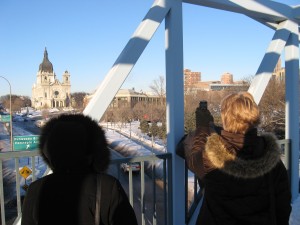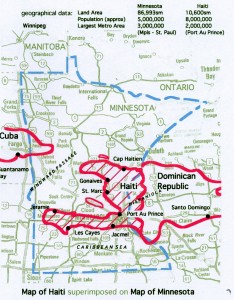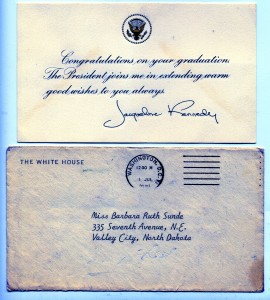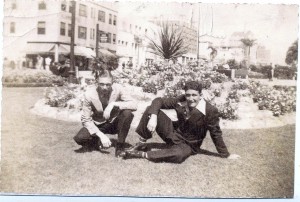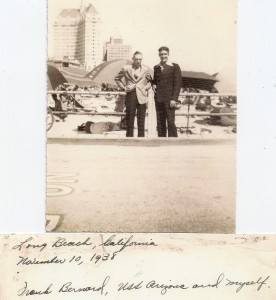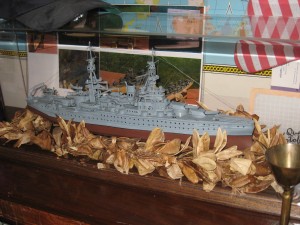Post directly related to the following: here
It’s nearing a week since the horrific massacre in Tucson.
Most everyone has weighed in – predictably one way, or the other, cleverly supporting their own bias by carefully groomed and manicured statements.
What is clear to me is this: it will be impossible to establish direct cause and effect between the actions of a mentally ill killer, and the political and media and fringe political establishments as the Tea Party. Equally, it will be impossible to convincingly deny the indirect impact that their actions have in contributing to this single piece of evidence of national insanity. We change our national behavior, or we will continue to kill ourselves in all senses of that word “kill”.
As the last few days have passed, several recurrent thoughts – memories, really – come to mind:
On Halloween evening 2000, a week before the 2000 election, my wife and I were in Washington D.C. and had an opportunity to see the U.S. House of Representatives in an unusual evening session. There were only a few of us in the Gallery that evening, and below us were two clumps of legislators, one to our left, the other to our right. Presumably, they were Republicans and Democrats, divided as if by a wall. No one seemed to be paying attention to the speakers. Most were standing.
At some point a man appeared in the Gallery and identified himself as one of the Congressmen. He was a Republican, and he was from somewhere in Illinois, and he apologized for his colleagues behavior down below. There was no particular drama occurring below, but the way in which business was being conducted clearly bothered him. I don’t remember his name. What was happening had likely been troubling to him for some time.
Six years later, in May of 2006, we were back in Washington, and this time we visited Ford’s Theatre, as well as the museum in the lower level of the Theatre. There were many interesting artifacts in this museum, just below where Abraham Lincoln had been assassinated 141 years earlier, but one particularly caught my eye – a political campaign poster from the 1860 campaign. Actually, what attracted my eye was the caption on the poster (click on the photo to enlarge it).
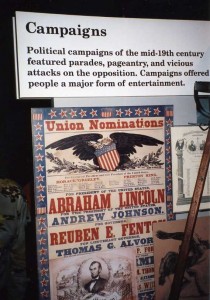
1864 Presidential Campaign Poster
. We had received the November, 2008, issue of Smithsonian Magazine, and there was a fascinating article by Harold Holzer (Election Day 1860) about the 1860 Presidential election which brought Abraham Lincoln into office. At page 51 I saw this quote “
…more than four million white males began registering their choices for the presidency.”
In 1860, the U.S. population was a bit over 31 million. Roughly one of eight Americans were participants in that election. Today we are a country with ten times the 1860 population: well over 300,000,000.
In 1860, unless you were a white man, probably educated and property owner to boot, you did not participate in the U.S. elections. It was a white man’s world, then, and duels and physical violence were almost a part of the political tradition and lore. For purposes of apportioning representatives to Congress, slaves counted as 3/5 of a person. Women did not receive the franchise until 1920. During the Civil War, slaves were emancipated, but only by proclamation, and it was 100 years before their descendants would, grudgingly, be allowed to engage fully as citizens. .
In those days of old, there was political violence, but it was personal and mostly in person. By 1864 telegraph could spread the word, and there were newspapers which some could read. It was unlike today when messages can suggest violence without actually saying so out loud and reach everyone 24 hours a day. The un-hinged can pick up suggestions to do evil things, without anyone worrying about being blamed for putting them up to the evil.
I feel this backdrop is a useful framework of reference for personally considering the blatantly suggestive violent talk in today’s heated political conversations.
What is surprising is that the politicians who are most high profile in this current debate are prominent women politicians, and they are high profile because they had no problem suggesting violent methods to take charge of government. Suggestions of violent means to overtake the government are red meat for their core base.
I think sanity can prevail in the coming months and years, and that change is possible, but only if individuals in sundry ways make absolutely clear to their elected representatives, and their political parties, that the violent suggestions and talk must stop, and ‘winner take all’ politics is destroying us all – including the temporary winners.
Several years ago I attended a workshop conducted by a Catholic Priest and a Rabbi on the Ten Commandments. It was a most interesting and useful workshop.
One of the lessons which stuck was about the Jewish interpretation of murder…in the Jewish view, one important kind of murder was what we would now call character assassination.
Were this to prevail in our society today, political campaigns as we presently see them would basically cease to exist – character assassination is a staple.
My bottom line: The caption on the 1864 campaign poster says it all: politics has been and is a spectator sport. Today, we simply watch it at home, 24 hours a day, if we wish. Our passive reaction to political violence, particularly daily character assassination, is killing us all.
Perhaps there’s hope for change in the political conversation, but only if we make it so. But we will have to make it so – no one else can do it for us.
UPDATE JANUARY 15, 2011:
I’ve decided to add in the contents of an e-mail received today, from someone identified only as JoJo (see comment from Jeff, following JoJo’s). It is an interesting commentary: (I am Statistics-challenged….)
Boston, MA
January 14th, 2011
8:09 pm
Was the Violence in Tucson Unrelated to Politics and Political Rhetoric?
I’m a professional statistician (and a political moderate). How likely is it that the recent violence in Tucson had nothing to do with politics and excessive political rhetoric in the media and among some politicians, alleged to be mostly coming from the right end of the political spectrum?
Assuming the violence had nothing to do with politics and political rhetoric:
The probability that this happened by chance alone in arguably the state having the most contentious political discourse (Arizona) = approximately 1/50 = 0.02 (because there are 50 states and Arizona is roughly average in size and population).
The probability that this happened by chance to a liberal/centrist Democratic congressperson (Ms. Gabrielle Giffords) as opposed to a Republican congressperson =1/2 = 0.5. (One of the other victims, Judge John Roll, was a Republican who received threats last year because he made a controversial ruling in favor of illegal Mexican immigrants, but was apparently not an intended target in Tucson).
What is the probability of this happening at this point in time in Arizona when the political atmosphere is so heated because of the recently passed healthcare law and the illegal immigrant problem? This is very difficult to assign, but erring on the side of being mid-range to high, I’ll say 0.5.
The probability of all three of these things happening at the same time by chance, assuming they are independent = 0.02 X 0.5 X 0.5 = 0.005, i.e., half of one percent. (The convention in the behavioral sciences for tentatively rejecting a hypothesis is that the probability of the observed event, assuming that hypothesis is true, is less than or equal to 0.05).
This is admittedly a crude estimation, based on assumptions (e.g., that beyond the political issues, it was rhetoric per se that was operative), incomplete evidence, and possibly omitting important considerations (e.g., the legal availability of guns in Arizona, previous violent politically related threats and actions against Giffords and Roll, the florid insanity of the perpetrator, etc.), which could make the estimate go up or down. This doesn’t prove anything with certainty, and even something with a low probability can still be true.
Assuming the violence in Tucson had nothing to do with politics or excessive political rhetoric, the probability of this happening for purely unrelated reasons and/or chance alone, and that therefore we need do nothing about toning down political rhetoric on both sides of the spectrum, is less than one percent by this estimation process. In making decisions we should also weigh the costs of errors in both directions, e.g., unnecessarily inhibiting freedom of speech vs. inciting more violent incidents against innocents.
Decide for yourself.
My intent is not to support any extreme unsubstantiated position that blames the Tucson tragedy entirely on partisan political rhetoric on one side or the other, but any claim that the one had nothing at all to do with the other, seems to me suspect based on what we know now. As President Obama suggested in his speech in Tucson, given the seemingly deranged mind of the perpetrator, we may never know for sure the reasons that led to these events, and not recriminations, but perhaps a voluntary, precautionary return to civility by all sides would seem to be wise.
From Jeff: It [above] was in a comment to an opinionator piece in the NYT [New York Times] today. I found it interesting as well.
Rachel Maddow [MSNBC] had stats last week on gun related murders by state … the top 5 states of gun ownership have the top 5 murder rates by gunshot, the bottom 5 states for gun ownership have the 5 lowest rates
Of murder by gunshot.
UPDATE Jan. 16, 2011:
from Mary B. – In my job, I had to give the Tennesen warnings [http://www.ipad.state.mn.us/docs/tw.pdf] during certain interviews about areas that might involve criminal violations.
I also educated my clients about terroristic threats given or received.
In my civilian role, I end up still educating people about the law regarding terroristic threats, and I wonder if others do the same.
Or do we just dismiss violent words as part of the culture…and threats as blowing off steam. Or are we cynical about the laws being implemented.(a lot of energy and money goes for implementing anti-terrorism strategies)
I would remind the speakers of vitriolic thoughts that the witnesses were also injured by words – not just the intended victim.
I sense currently our American people are like domestic emotional abuse victims who identify with the bully for survival, in an emotionally damaging public interchange.
I could use support for my stance which does not seem congruent with common culture. We seem awash in nastiness that I am not yet numbed by.
Also-where is the conversation about the fragmentation of our health care system in this Tucson horrifying scenario…..
Mary
Later, Mary added this:
As a public sector social worker, I was in a professional role to assess risk and defuse and de-escalate varied situations – adult and student threats of various types, from playground stuff to very serious issues,like gang threats, weapons in school(both staff and students) kidnapping, suicide, trafficking, etc. Most situations varied in the levels of support or involvement from co-workers or administration. I was asked to do home visits when students were suspended for weapons.
In the space of my career It became more and more difficult to find or bring resources to students and families in need of health and mental health services. Many slip through the ever widening cracks.
I am proud to have had no one under my direct guard physically injured except myself in 30 years of social service. I have attempted to intervene and been thwarted with students who later were murdered or murdered. I have also prevented violence, quietly, with teamwork at its best. Children who have not had voices snuffed or blotted by media want a safer world and contributed greatly to this teamwork. I wish we did not need them to see truth and danger related, but it is related.

